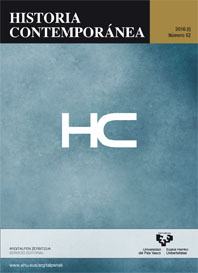Liberal resistance and international liberalism in Cadiz during Spain's Second Restoration
##plugins.themes.bootstrap3.article.main##
##plugins.themes.bootstrap3.article.sidebar##
Abstract
This paper analyzes the role played by the Cadiz-Gibraltar axis in the liberal resistance to absolutism during the last years of Ferdinand VII reign. The strength of this axis was based on the fluidity of the relations between two exceptional spaces. On the one hand, Gibraltar, where the confluence of economical and political interests favored the collaboration between Spanish, European and American conspirators. On the other hand, Cadiz, which became a kind of promised land for those determined to maintain the struggle against absolutism, mainly due to the presence of the French division established after the campaign of the so-called Hundred Thousand Sons of Saint Louis, since their commanders did not allow Spanish authorities to carry out indiscriminate persecution of liberals. The result was the configuration of an advantageous space to conspiracy, which not only made possible an understanding between liberal refugees in both cities, but also, as Spanish authorities criticized, the participation in conspiracies of a transnational extent.
##plugins.themes.bootstrap3.article.details##
Liberalism, Absolutism, Conspiracy, Cadiz, Gibraltar, French occupation
Authors publishing in the journal Historia Contemporánea agree to the following terms:
- Authors retain full copyright of their papers, but also grant copyright to the academic publisher (UPV/EHU Press) for the purposes of copyright management, vigilance and protection.
- Papers are by default published with a non-restrictive Creative Commons CC-BY-NC-ND 4.0. You are free to: Share, copy and redistribute the material in any medium or format. The licensor cannot revoke these freedoms as long as you follow the license terms. Under the following terms:
Attribution — You must give appropriate credit, provide a link to the license, and indicate if changes were made. You may do so in any reasonable manner, but not in any way that suggests the licensor endorses you or your use.
NonCommercial — You may not use the material for commercial purposes.
NoDerivatives — If you remix, transform, or build upon the material, you may not distribute the modified material.
No additional restrictions — You may not apply legal terms or technological measures that legally restrict others from doing anything the license permits.
- If an author requires a more restricted CC license (e.g. CC-BY-SA), this can be provided by contacting our publisher at: publications@ehu.eus
- In particular, and without having to request additional permission, CC BY-NC-ND licensed papers can be deposited in institutional repositories and academic web sites.
- Postprints (i.e. accepted but non-edited versions of the manuscript) can also be pre-published online, providing acknowledgement of authorship and source is specified as above.
For non-standard uses of papers or materials published in Historia Contemporánea, please contact our publisher UPV/EHU Press at: publications@ehu.eus

